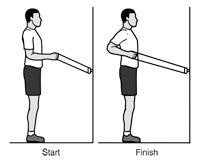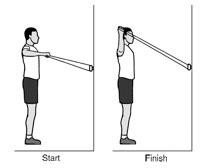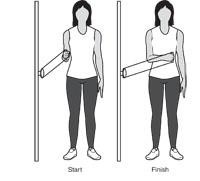Swimming Strengthening and Stretching Exercises
- Category: Orthopedic Health, Shoulder, Sports Medicine, Elbow
- Posted On:
- Written By: Dr. Bradley Greenbaum

Summer is upon us and with temperatures in Southern California warming up, many will flock to the pools to cool down. No doubt that swimming is a great form of exercise and extremely popular. It offers reduced stress on bones and joints, which makes it ideal for those suffering from any arthritic conditions. In order to enjoy your summer full of swimming and avoid injury, it is recommended to maintain flexibility and strength around the shoulder through stretching and strengthening exercises.
Rotator cuff muscles are extremely important to maintain proper shoulder joint mechanics. Repetitive overhead efforts, such as swimming, tend to put a heavy emphasis on the cuff. Therefore, it is wise to maintain a basic level of cuff strength to keep these muscles working properly.
One of Hoag Orthopedic Institute sports medicine doctors shared seven cuff strengthening and stretching exercises also recommended by the American Academy of Orthopaedic Surgery (AAOS) including the following:
1) Standing Row
Main muscles worked: Middle and lower trapezius
You should feel this exercise at the back of your shoulder and into your upper back
Use an elastic stretch band of comfortable resistance. Stand holding the band with your elbow bent and at your side, as shown in the start position. Keep your arm close to your side and slowly pull your elbow straight back. Slowly return to the start position and repeat. Tip: Squeeze your shoulder blades together as you pull.

2) External Rotation With Arm Abducted 90°
Main muscles worked: Infraspinatus and teres minor
You should feel this exercise at the back of your shoulder and into your upper back.
Use an elastic stretch band of comfortable resistance. Stand holding the band with your elbow bent 90° and raised to shoulder-height, as shown in the start position. Keeping your shoulder and elbow level, slowly raise your hand until it is in line with your head. Slowly return to the start position and repeat. Tip: Make sure your elbow stays in line with your shoulder.

3) External Rotation
Main muscles worked: Infraspinatus, teres minor, posterior deltoid.
You should feel this stretch in the back of your shoulder and upper back
Stand holding the band with your elbow bent and at your side, as shown in the start position. Keeping your elbow close to your side, slowly rotate your arm outward. Slowly return to the start position and repeat. Tip: Squeeze your shoulder blades together when you pull your elbow back. Keep your elbow pinned to your side.

4) Internal Rotation
Main muscles worked: Pectoralis, subscapularis.
You should feel this exercise at your chest and shoulder
Stand holding the band with your elbow bent and at your side, as shown in the start position. Keep your elbow close to your side and bring your arm across your body. Slowly return to the start position and repeat. Tip: Keep your elbow pressed into your side.

As a result swimming, four muscle groups around the shoulder tend to shorten. In an effort to maintain normal rotation range of motion, avoid muscle imbalance, and prevent dysfunctional shoulder mechanics, it is recommended to stretch the following muscles: 1) Upper Trapezius, 2) Levator Scapulae, 3) Pectoralis Major and Minor and 4) the Latissimus Dorsi. The following stretches can be very helpful in doing so:
1) Doorway or Corner Stretch (for pectoral group)
Stand at doorway with forearm on doorframe. Elbow bent to 90 degrees. Step through the door. Or stand in a corner with the arms on the wall and elbow flexed 90 degrees. A good stretch should be felt along the anterior chest, not the shoulder joint. If you are stretching the right shoulder, step through with the right leg keeping the left chest open. Complete 3 x 30 seconds each side.
2) Latissimus Dorsi Stretch
While on all fours, do the “angry cat” stretch by arching your back up like to round out your back. Keep your back rounded and drop your rear to
your heels. Reach out with your hands and then reach to a side to specify the stretch and address each of the Latissimus Dorsi. Hold each stretch 30 seconds and repeat three times, alternating sides.
3) Upper Trapezius/Levator Scapular Stretch
Sit on a chair and grasp the seat with the hand on the side of the tightness to anchor yourself down in the chair. Place your opposite hand over your head towards the ear (on the tight side) and gently pull down and diagonally towards the opposite side. Two versions of this stretch are possible. The first version is to turn your nose towards your opposite armpit and gently pull down. The second version is to look straight ahead and gently pull down. Hold for 30 seconds and repeat three times, alternating sides.
Hope this helps you to enjoy your pool time all summer long. For more info, visit the American Academy of Orthopaedic Surgery at www.AAOS.org.


